Corellas are such entertaining characters. Over the past couple of weeks I’ve spent time lying on a damp hill watching Little Corellas at play, the late afternoon light didn’t make photography easy but I tried to get images that captured the fun.
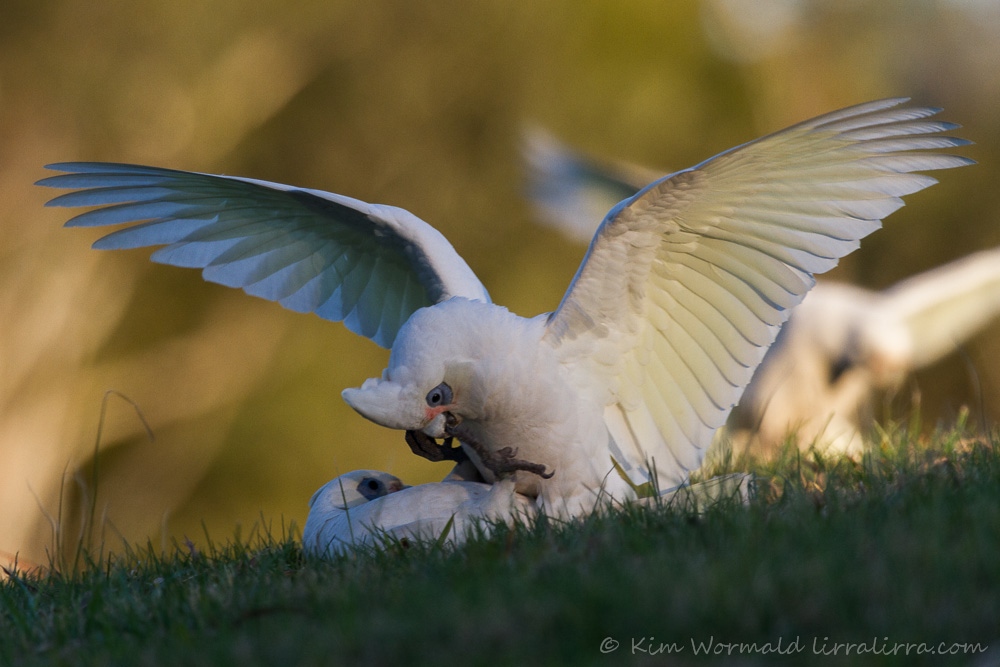 Little Corella (Cacatua sanguinea)
Little Corella (Cacatua sanguinea)
Canon 7D, 100-400mm L IS USM, 1/400mm, f/6.3, ISO 400, focal length 400mm
There was a crazed sqawking on the hill with scores of Little Corellas wrestling in pairs. One bird from each pair was on its back while the other shrieked, spread its wings and often nibbled the toes of its partner! For the image above I crawled slowly towards the birds, not wanting to risk disturbing them but very aware that the foreground was already in shade as the sun was setting, and hoping the light would last long enough for an image or two. I took these images just as the shadow of the earth reached the birds. Their behaviour is echoed in the out of focus pair in the background.
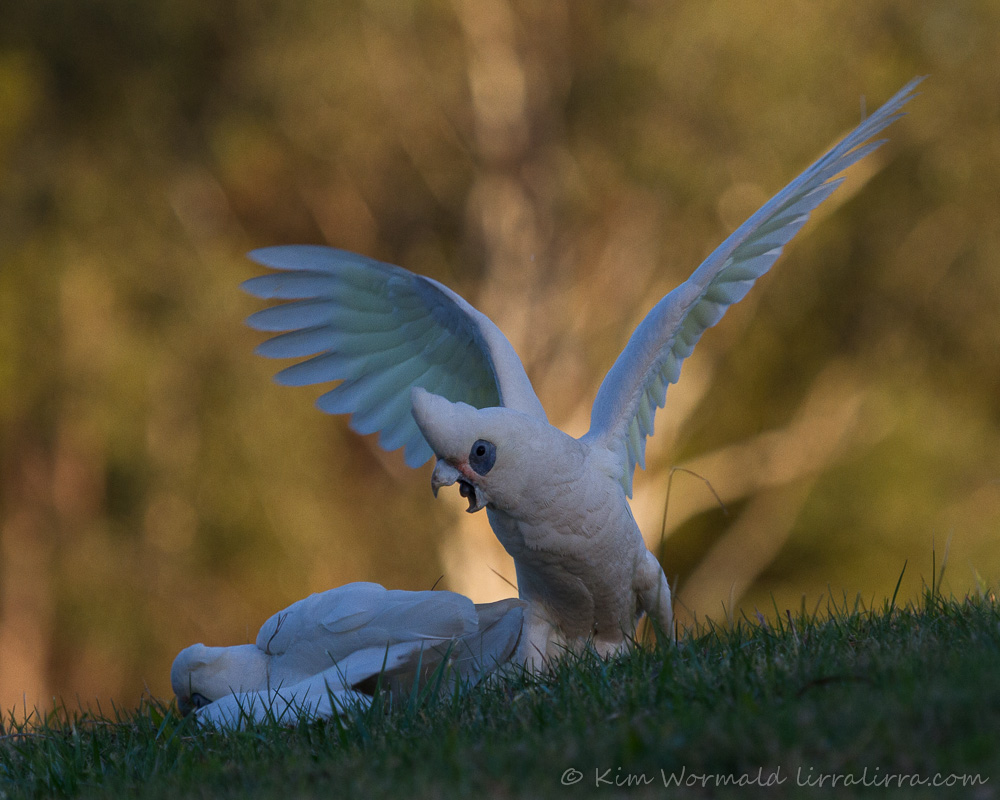 Little Corella (Cacatua sanguinea)
Little Corella (Cacatua sanguinea)
Canon 7D, 100-400mm L IS USM, 1/400, f/6.3, ISO 400, focal length 260mm
The corellas were very dramatic. I didn’t see any of the birds change roles, I wonder if they do, I wonder if the behaviour has been researched. In the image above the prone bird appears to be cowering while the upright bird expresses dominance; I didn’t get that feeling while watching them, it seemed more of a dance.
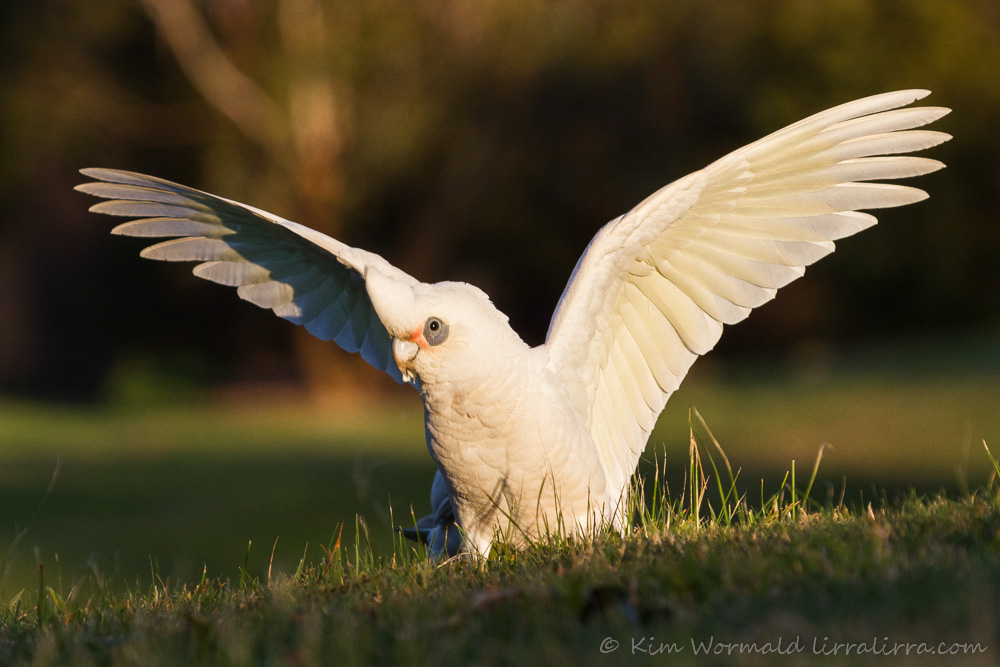 Little Corella (Cacatua sanguinea)
Little Corella (Cacatua sanguinea)
Canon 7D, 100-400mm L IS USM, 1/500, f/6.3, ISO 400, focal length 285mm
I like this exuberant pose, above, and the way the Little Corella’s wings are catching the last of the day’s light.
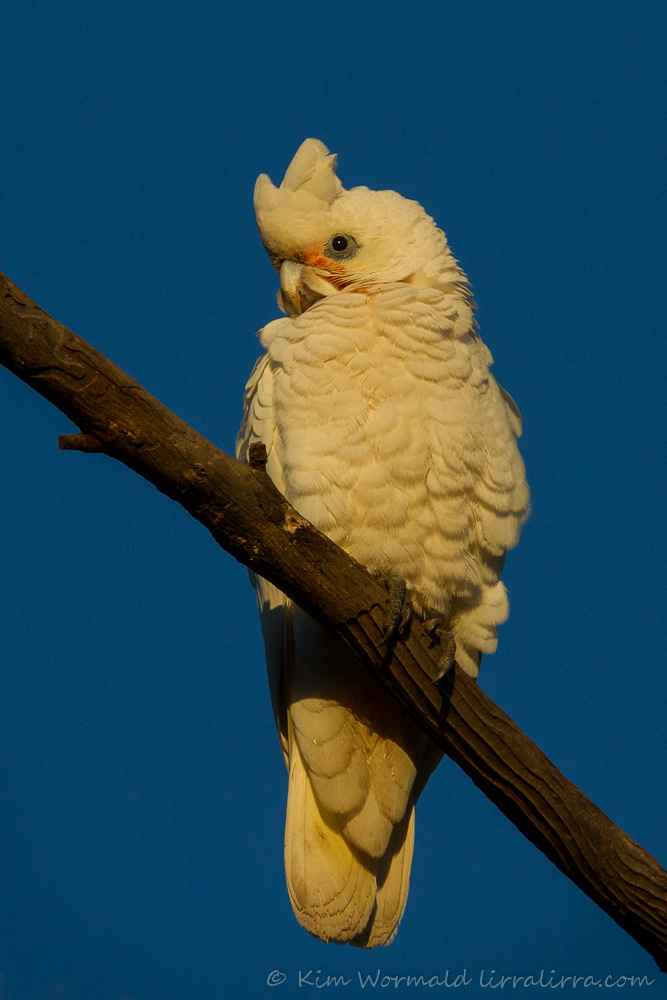 Little Corella (Cacatua sanguinea)
Little Corella (Cacatua sanguinea)
Canon 7D, 100-400mm L IS USM, 1/640, f/8.0, ISO 250, focal length 330mm
As the sun went down the corellas left the hill and took to the trees where they played crazy dangling games in the shade where it was too dark to get a clear image. Others preened and posed, like the Little Corella above, in the last rays of sunshine. This bird’s feathers look so soft as it watched me from its lofty perch. The groves on the branch look like borer damage but it’s curious how they stop so abruptly.
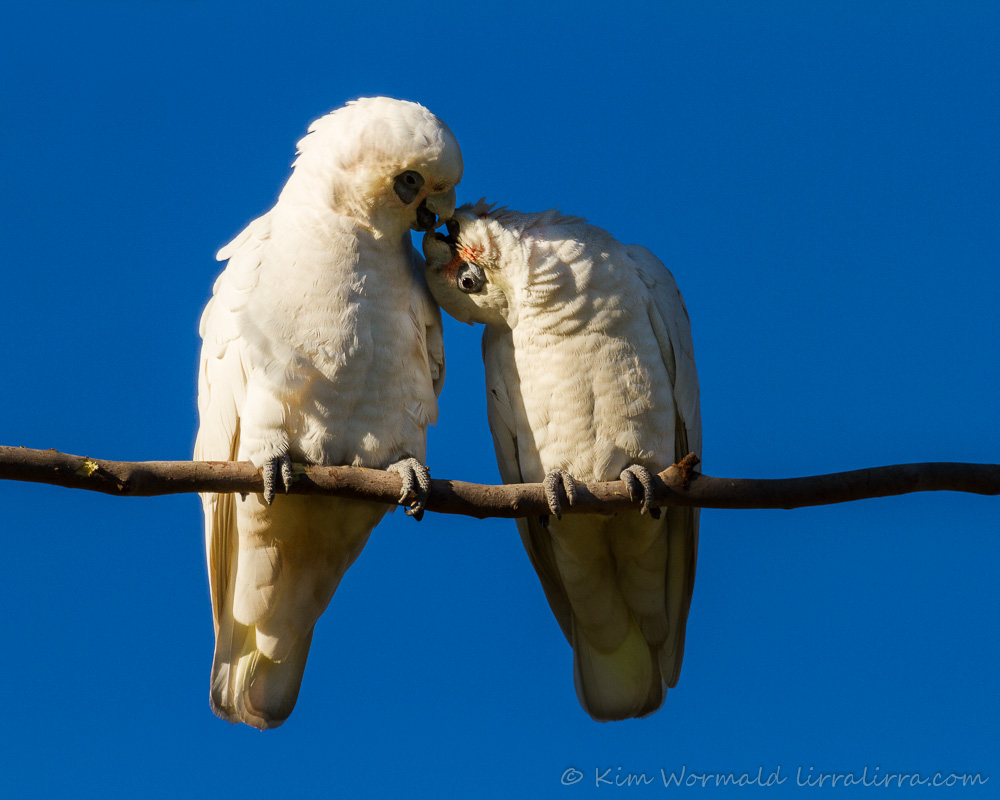 Little Corella (Cacatua sanguinea)
Little Corella (Cacatua sanguinea)
Canon 7D, 100-400mm L IS USM, 1/500, f/5.6, ISO 125, focal length 400mm
I visited the lake again the following week and when the sun was just about set I had the pleasure of watching the couple above canoodling. There wasn’t quite enough light for the photo but I include it because the memory makes me smile. Little Corellas are believed to mate for life and these two were very tender with each other.
 Little Corella (Cacatua sanguinea)
Little Corella (Cacatua sanguinea)
Canon 7D, 100-400mm L IS USM, 1/1600, f/5.6, ISO 100, focal length 400mm
Little Corellas feed mainly on grass seeds and bulbs. Seeing flocks of them on the ground or in trees is a beautiful sight. However, some communities are bothered by the noise, pollution and damage to trees, crops, ovals and property.
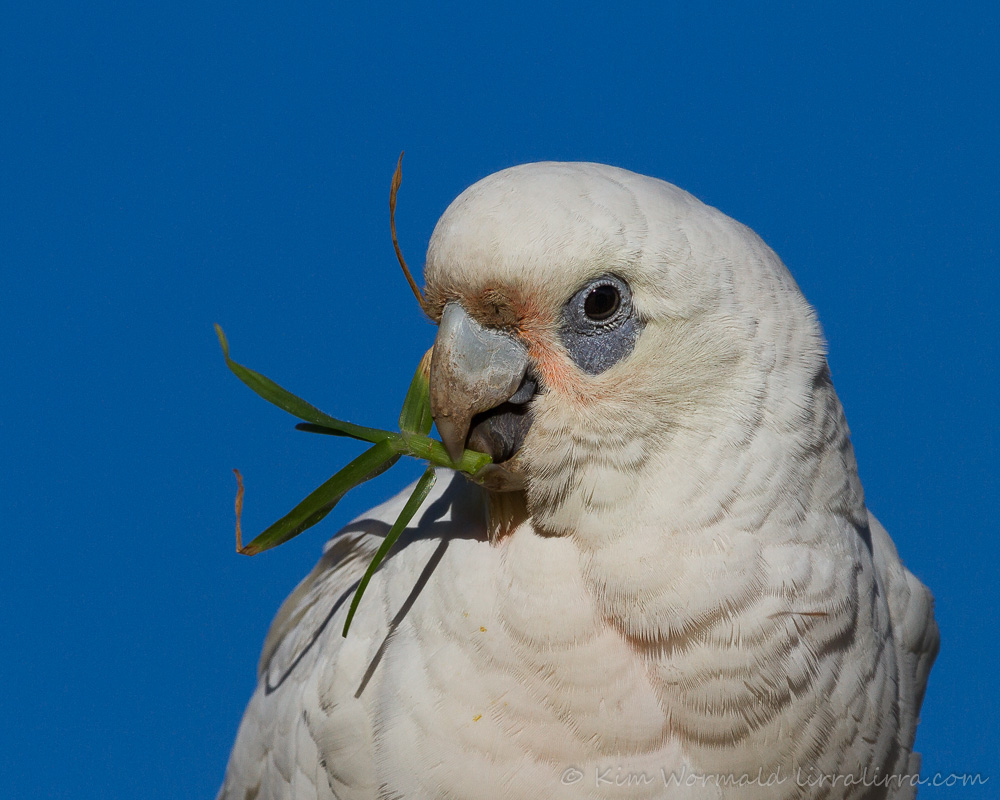 Little Corella (Cacatua sanguinea)
Little Corella (Cacatua sanguinea)
Canon 7D, 100-400mm L IS USM, 1/1250, f/6.3, ISO 100, focal length 390mm
The Little Corellas were picking grass which had no seeds. They focused on the cut end of the grass which they squished before dropping. Because the corellas were on the side of a small hill I was able to change the background to sky by lying completely flat and looking up at the birds. It was a little damp but not too bad, the funny thing was getting up to find that I was covered in grass clippings that the corellas had discarded.
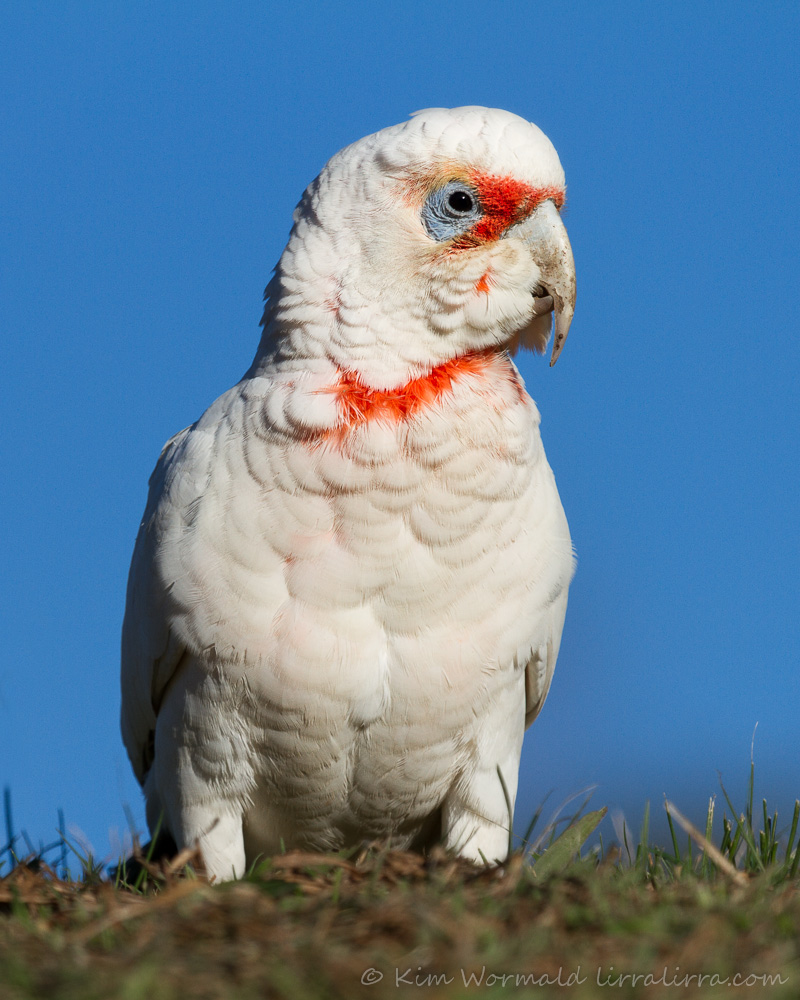 Long-billed Corella (Cacatua tenuirostris)
Long-billed Corella (Cacatua tenuirostris)
Canon 7D, 100-400mm L IS USM, 1/640, f/6.3, ISO 100, focal length 365mm
I was preparing to leave when a Long-billed Corella waddled over the horizon and stared straight into my camera lens. Their bills are longer than the bills of Little Corellas and they have a distinct orangy-red crescent across their chests. They use their long, curved bill to prise up tufts of grass by the roots.
It is exactly a year ago that lirralirra went live and since then there have been almost 5000 visits to the site from 75 countries. During the year I have found many inspiring blogs where kindred spirits share their images and love of nature – what a wonderful world we share.
Happy birding, Kim
NB It is now possible to receive a weekly email letting you know that lirralirra has been updated – just add your address to the ‘Subscribe to email’ box above right.
Also, I recently added a Facebook ‘like’ button. Thank you to all ‘likers’ – I like you too!

Nice work Kim
I attempt to count Long-billed at a wind farm near Dunkeld. There are hundreds and as you have captured, they have fascinating behaviour.
Cya
Malcolm
I can imagine the sight Malcolm, a sea of whitecaps that are impossible to count! I’m off to Dunkeld later in the year and will look out for the wind farm and, of course, the birds. Thank you for your comments, Kim
Kim,
Your photography is spectacular. My wife and I will be visiting Queensland on a birding trip mid Sept-mid Oct. Viewing your blog has added to our anticipation of a wonderful trip.
Hi Barry, thank you for letting me know how much you enjoyed the images. I hope you have a wonderful birding adventure in springtime and see many of the exquisite Queensland species.
ohhh, they are so nice, you have got plenty of different attitude, specialy on 1st shots during the play moment ;))
you have got a very nice moment with them, a big bravo =))
take care and happy birding of course
They really do have attitude Eric! I’m glad you liked the first shots, it was a shame that the sun set so rapidly, it would have been good to have a little longer with the light. You take care too
Kim, those are amazing shots and they are quite the characters. I’m a captive parrot Mom so it tugs at my heart to see them in the wild and totally understand that they are considered pests in your part of the world. Still I’m so glad you shared with us!
Hi Sherry, I’m glad you liked the shots of the corellas. They aren’t considered pests everywhere, just a few communities where they have caused significant damage, but it’s a shame they are thought of as pests anywhere.
Hello Kim
lovely photos…well worth the time spent laying on the damp hill.
Congratulations, 5000 visits, that is some milestone.
Before long you will be a house hold name in 75 countries.
Carole
Thank you Carole! And LOL re being a household name in 75 countries, so funny. Some of those hits would have been poor people googling something completely different, but the interest in Australian birds is amazing and inspiring.
Wow, these are awesome shots of the Corellas. Great series, watching them at play. And the closeups are beautiful. A cool bird to see in the wild. Have a happy weekend!
It was a lot of fun Eileen, they were so exuberant. They’d be a sad bird to see in captivity. Thank you for commenting